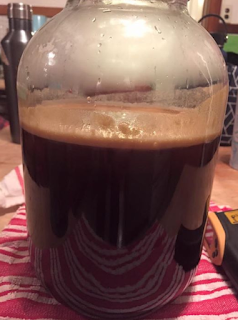I saw a bochet on a facebook post and looked up what it mean. Bochet (Boh shett) is a mead where you boil the honey first to caramelize it and deepen the flavor. I wanted to try some of my new Christmas toys and I had some honey so I thought, why not! I asked Mary B for suggestions for flavor and she decided vanilla lavender would be nice. And so it began...
I measured exactly 3 lbs of honey and put it on the stove and heated it slowly. Since we have an electric stove I had to be really careful to not let it burn. I used an infrared thermometer to monitor the progress as I stirred; I stirred a lot! At over 240º it was boiling. I turned the heat back to where it would boil but not super rapidly and boiled it for about 20 minutes. Then took it off and let it cool.
I used a clean 12lb (1 gallon) honey jar and poured the warm honey in and filed the rest with water. I wanted to try a math experiment that I thought up. A gallon of liquid sugar weighs 11 lbs. A gallon of alcohol weighs 6.6 lbs. Water weighs 8 lbs per gallon. Alcohol weighs 60% of the weight of sugar. So I thought that maybe I could use the weight difference between starting and ending to determine how much sugar was converted into alcohol. I made an assumption that no water will evaporate. I know that strictly-speaking that's not true but I'm working with rough estimates for fun. A true experiment would have a non-fermenting control but what fun would that be?
So here are the starting numbers:
3 lb Honey
8 tbsp Vanilla
1 tsp lavender
Water
Jan 7 2020
SG 1.100 25% sugar
Total weight 10lb 7.2oz
Jan 15
9lb 13oz
1.042 7% sugar
So here's my math experiment. Convert weight to decimal:
10.45 lb
9.8125 lb
Difference: 0.6375 More than half a pound. That's impressive. So, if I didn't know the starting amount of sugar and I just wanted to know how much alcohol has been created I should be able to determine that by the amount of weight lost.
I started with 3lb of honey. If it all converted to alcohol the final weight should be 60% of that or 1.8 lbs. that's a difference of 1.2 lbs. Does the math work out? A difference of 4.4 lbs is one gallon of alcohol. 1.2lbs is .27 gallons of alcohol. That's close to the original sugar reading. When the conversion happens you end up with 60% less volume as well. So you have to take that into consideration so you get 16.2% alcohol.
So, using what I learned above I should have converted 0.1448 gallons of alcohol which reduced for volume is 8.5% alcohol. That's seems about right. So this means I can use a difference in weight to determine the ABV. Fun stuff.
So after all of that, all I really care about is the taste. I swapped out jars to take it off of the old yeast and had a taste. It's very tasty. It has a sweet front with a bitter after taste that I like. I think the bitter is the lavender, Mary B thinks it's the caramelization. I took some new numbers when I racked it (listed above). Since I used KV1116 yeast which maxes out at 18% alcohol this will probably finish dry but we can either drink it before that time or see how it tastes when dry. Either way I think it will be very good.
Drank it, loved it. Had a half quart left over that I let sit for a month to see how clear it would get. It cleared nicely and was oh so tasty. And, alas, it is gone. I'll have to make this again sometime.
Skål!
















